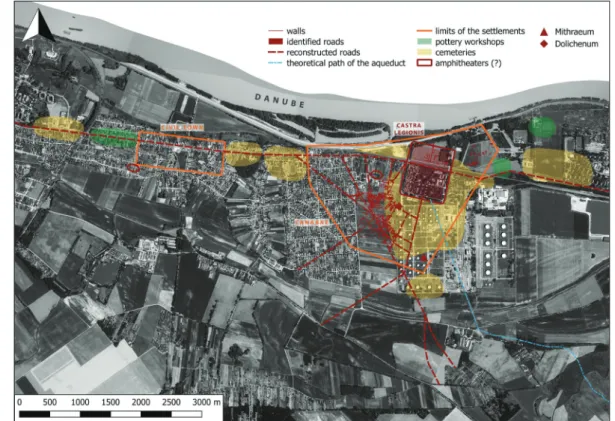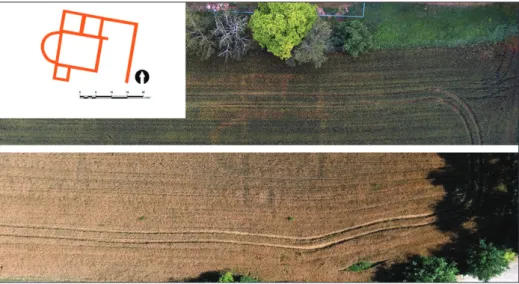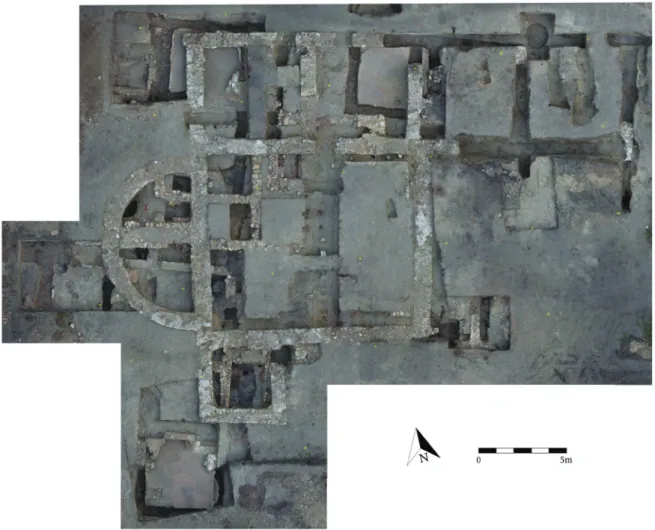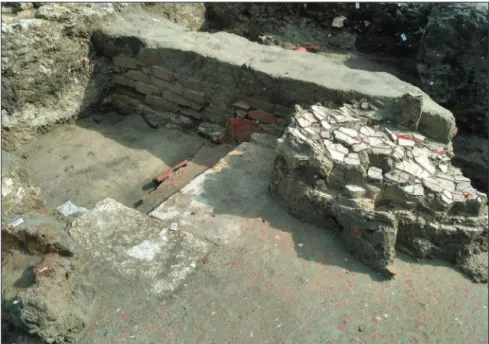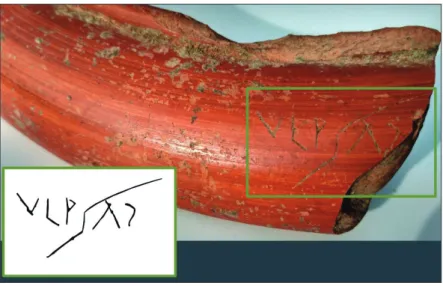Ser. 3. No. 6. 2018 |
ex Instituto Archaeologico Universitatis de Rolando Eötvös nominatae
DISSERT A TIONES ARCHAEOLO GICAE
Arch Diss 2018 3.6
D IS S E R T A T IO N E S A R C H A E O L O G IC A E
Dissertationes Archaeologicae
ex Instituto Archaeologico
Universitatis de Rolando Eötvös nominatae Ser. 3. No. 6.
Budapest 2018
Dissertationes Archaeologicae ex Instituto Archaeologico Universitatis de Rolando Eötvös nominatae
Ser. 3. No. 6.
Editor-in-chief:
Dávid Bartus Editorial board:
László BartosieWicz László Borhy Zoltán Czajlik
István Feld Gábor Kalla
Pál Raczky Miklós Szabó Tivadar Vida
Technical editor:
Gábor Váczi Proofreading:
ZsóFia KondÉ Szilvia Bartus-Szöllősi
Aviable online at htt p://dissarch.elte.hu Contact: dissarch@btk.elte.hu
© Eötvös Loránd University, Institute of Archaeological Sciences Layout and cover design: Gábor Váczi
Budapest 2018
Contents
Zsolt Mester 9
In memoriam Jacques Tixier (1925–2018)
Articles
Katalin Sebők 13
On the possibilities of interpreting Neolithic pottery – Az újkőkori kerámia értelmezési lehetőségeiről
András Füzesi – Pál Raczky 43
Öcsöd-Kováshalom. Potscape of a Late Neolithic site in the Tisza region
Katalin Sebők – Norbert Faragó 147
Theory into practice: basic connections and stylistic affiliations of the Late Neolithic settlement at Pusztataskony-Ledence 1
Eszter Solnay 179
Early Copper Age Graves from Polgár-Nagy-Kasziba
László Gucsi – Nóra Szabó 217
Examination and possible interpretations of a Middle Bronze Age structured deposition
Kristóf Fülöp 287
Why is it so rare and random to find pyre sites? Two cremation experiments to understand the characteristics of pyre sites and their investigational possibilities
Gábor János Tarbay 313
“Looted Warriors” from Eastern Europe
Péter Mogyorós 361
Pre-Scythian burial in Tiszakürt
Szilvia Joháczi 371
A New Method in the Attribution? Attempts of the Employment of Geometric Morphometrics in the Attribution of Late Archaic Attic Lekythoi
Anita Benes 419 The Roman aqueduct of Brigetio
Lajos Juhász 441
A republican plated denarius from Aquincum
Barbara Hajdu 445
Terra sigillata from the territory of the civil town of Brigetio
Krisztina Hoppál – István Vida – Shinatria Adhityatama – Lu Yahui 461
‘All that glitters is not Roman’. Roman coins discovered in East Java, Indonesia.
A study on new data with an overview on other coins discovered beyond India
Field Reports
Zsolt Mester – Ferenc Cserpák – Norbert Faragó 493
Preliminary report on the excavation at Andornaktálya-Marinka in 2018
Kristóf Fülöp – Denisa M. Lönhardt – Nóra Szabó – Gábor Váczi 499 Preliminary report on the excavation of the site Tiszakürt-Zsilke-tanya
Bence Simon – Szilvia Joháczi – Zita Kis 515
Short report on a rescue excavation of a prehistoric and Árpádian Age site near Tura (Pest County, Hungary)
Zoltán Czajlik – Katalin Novinszki-Groma – László Rupnik – András Bödőcs – et al. 527 Archaeological investigations on the Süttő plateau in 2018
Dávid Bartus – László Borhy – Szilvia Joháczi – Emese Számadó 541 Short report on the excavations in the legionary fortress of Brigetio (2017–2018)
Bence Simon – Szilvia Joháczi 549
Short report on the rescue excavations in the Roman Age Barbaricum near Abony (Pest County, Hungary)
Szabolcs Balázs Nagy 557
Recent excavations at the medieval castle of Bánd
Thesis Abstracts
Rita Jeney 573
Lost Collection from a Lost River: Interpreting Sir Aurel Stein’s “Sarasvatī Tour”
in the History of South Asian Archaeology
István Vida 591
The Chronology of the Marcomannic-Sarmatian wars. The Danubian wars of Marcus Aurelius in the light of numismatics
Zsófia Masek 597
Settlement History of the Middle Tisza Region in the 4th–6th centuries AD.
According to the Evaluation of the Material from Rákóczifalva-Bagi-földek 5–8–8A sites
Alpár Dobos 621
Transformations of the human communities in the eastern part of the Carpathian Basin between the middle of the 5th and 7th century. Row-grave cemeteries in Transylvania, Partium and Banat
DissArch Ser. 3. No. 6. (2018) 541–547. DOI: 10.17204/dissarch.2018.541
Short report on the excavations in the legionary fortress of Brigetio (2017–2018)
Dávid Bartus László Borhy
Institute of Archaeological Sciences Institute of Archaeological Sciences
Eötvös Loránd University Eötvös Loránd University
bartus.david@btk.elte.hu borhy.laszlo@btk.elte.hu
Szilvia Joháczi Emese Számadó
Institute of Archaeological Sciences Klapka György Museum
Eötvös Loránd University Komárom
johisziszi@gmail.com emese@jamk.hu
Abstract
After the aerial archaeological surveys of the preceding years, a new excavation project has been started in 2017 in the northern part of the legionary fortress of Brigetio. The main result of the seasons of 2017 and 2018 were the unearthing of a large Late Roman apsidal building, which can be most probably connected to the death of Valentinian I.
The legionary fortress of Brigetio is the least researched with modern methods of the three main topographical parts of Brigetio (civil town – canabae – castra legionis, Fig. 1). Apart from some small scale excavations in the middle of the 20th century, modern archaeological research has only been started in 2015, when we found the courtyard of the principia with well-identifiable stratigraphy and building periods at the site Szőny-Kiskertek.1 The most im- portant and unique find of this excavation was the bronze tablet containing the law of Philip- pus Arabs, which was found near the principia.2
Although the retentura of the legionary fortress is almost entirely covered by modern build- ings, the praetentura is under agricultural use and can be researched by remote sensing meth- ods. The northern wall and gate, the via praetoria, several other roads and buildings can be identifiable on aerial photos made in the last decades. Obviously the most interesting of all the cropmarks is the well recognisable trace of a large, apsidal building near the porta principalis dextra (Fig. 2–3).
In summer 2017 and 2018, a planned excavation was carried out to clarify the chronology and function of the apsidal building and to set out whether it was part of the legionary fortress or belonged to a period after the abandonment of the Roman settlement.3
1 Bartus et al. 2016.
2 Borhy et al. 2015a; Borhy et al. 2015b.
3 The excavation was conducted by the Department of Classical and Roman Archaeology, Faculty of Huma- nities, Eötvös Loránd University and the Klapka György Museum of Komárom under the overall direction of Dávid Bartus (Eötvös Loránd University), László Borhy (Eötvös Loránd University) and Emese Számadó
542
Dávid Bartus – László Borhy – Szilvia Joháczi – Emese Számadó
An excavation area of almost 1000 m2 was cleared after the removal of the topsoil, and as it turned out on the first day of the fieldwork, the remaining walls of the apsidal building were situated only about 30–40 centimetres below the soil surface, i. e. the level of current agricultural works. That resulted rather in broken ploughshares than destroyed walls, indi- cating that the walls were really massively built, as it was confirmed by the excavation, with a width of 1 metre and a foundation depth of 2 metres in places. Unlike most parts of Brige- tio, the whole area of the apsidal building, together with the walls of earlier periods, have survived the quarrying activities of the 19th and 20th centuries for as yet unknown reasons, which provides ideal circumstances for the research of the stratigraphy, chronology and building periods of the legionary fortress of Brigetio.
According to the results of the first two excavation seasons, the area of the apsidal bulding is approximately 600 m2, consisting of an apse on the western side, two large halls, and a number of smaller rooms (Fig. 4). The floor level of the building was very close to the level of the current agricultural works, therefore most of the floors and the architectural decora-
(Klapka György Museum). Vice-director of the fieldworks was Szilvia Joháczi (Eötvös Loránd University).
Participants were Anita Benes, Linda Dobosi, Barbara Hajdu, László Rupnik, Nikoletta Sey, Bence Simon, Eszter Süvegh and Melinda Szabó (archaeologists, Eötvös Loránd University), Gabriella Delbó (archaeologist, Klapka György Museum) and László Almády, Réka Ádám, Ferenc Barna, Regina Csordás, Piroska Derzsi, Bol- dizsár Ekker, Ákos Ekrik, Bianka Fenyvesi, András Füstös, Tamás Gál, Rebeka Gergácz, Dóra Havasi, Fruzsina Hege, Ádám Horváth, Bianka Horváth, Adrián Horváth-Lukics, Dániel Hümpfner, Regina Kapitány, Zsanett Kartali, Zsófia Zsuzsanna Kelemen, Dalma Kerekes, Boglárka Teodóra Kertész, Zoltán Kiss, Dalma Kollerits, Flóra Klinga, Dóra Tekla Králik, László Krén, Ágota Madai, Attila Marsi, Alexandra Mező, Ákos Müller, Anna Nagy, Rita Olasz, Zsolt Tamás Papp, Bence Párkányi, Daniella Pokker, Dániel Polyák, Alexandra Szabó, Már- ton Szabó, Róbert Szederkényi, Iringó Tatár, Adél Ternovácz, Benedek Tóth, Dorottya Török, Kíra Ujj, Dávid Váczi, Gergő Vincze. The excavation was supported by the National Research, Development and Innovation Office (NKFI 119520) and MTA-ELTE Research Group for Interdisciplinary Archaeology.
Fig. 1. Map of Brigetio (by L. Rupnik).
543 Short report on the excavations in the legionary fortress of Brigetio (2017–2018) tions of the building are missing now, together with the finds which could have been con- nected with the building. Although we know almost exclusively the walls of the building, it can be dated by a very fortunate find. A brick stamp of Terentius dux have been found in the last days of our excavation in August 2018, in a pit under one of the walls of the apsidal building, which gives a terminus a quo for the building. Additional brick stamps of Terenti- us dux and Frigeridus dux was found in the building in 2017, which indicate that it was built most likely by Frigeridus dux in the first years of the 370s under the reign of Valentinian I.
Fig. 2. Traces of the apsidal building on aerial photo (Photo: D. Bartus).
Fig. 3. Cropmarks indicating the apsidal building on aerial photos at different growing periods (Photos:
L. Rupnik).
544
Dávid Bartus – László Borhy – Szilvia Joháczi – Emese Számadó
Valentinian I was died in 17 November 375 somewhere in the legionary fortress of Brigetio, when he gave an audience to the Qu adi and suff ered a stroke, as told by Ammianus Marcel- linus, but the exact location of that was unknown until now. Although we have no direct ev- idence, the aula-like plan, the measures, and the datation of the building indicate that it was the most suitable place in the legionary fortress for an imperial audience, and Valentinian I was most likely died here.
As it has been mentioned before, several earlier periods were unearthed under the apsidal building with walls, fl oors and even wall-paintings in very good condition. Th e absolute chro- nology and the function of th ese buildings are still unclear in some points, but general obser- vations can be made of these periods, which belong obviously to the legionary fortress.
Th e earliest period was presented in the form of a black ash layer, which can be found in near- ly the whole area of the excavated surface. It can be connected with the foundation of the for- tress at the turn of the fi rst and second centuries AD, and the massive ash layer indicates that presumably the fi rst legionary fortress had – at least partly – timber structures. Th e datation of the destruction of these buildings is uncertain by now, but the Marcomannic wars can be a plausible option, which is in accordance with the massively burnt courtyard of the principia, excavated in 2015 at the site Szőny-Kiskertek.4
4 Bartus et al. 2016, 70–71.
Fig. 4. Orthophoto of the excavation season of 2017 (Photo and map: D. Bartus – L. Rupnik).
545 Short report on the excavations in the legionary fortress of Brigetio (2017–2018)
The next period is the main stone period of the legionary fortress, a large building with an area of at least 700 m2, consisting more than 30 rooms. The function of the building is not clearly identified yet, but it seems that the building was divided into symmetrically planned units of five rooms, one of them being a courtyard. Some of the rooms have terrazzo-floors in almost perfect condition (Fig. 5), but without hypocaust system. In one of them, wall-paintings with geometrical and floral decorations was found in situ (Fig. 6). A very important find came to light from this period: the rim of a mortarium with the cursive Latin inscription VLPSAB (Fig. 7), which refers to the owner of the pot, most likely a soldier named Ulpius Sabinus. A fragment of a bone stylus was also found near the inscribed potsherd. What makes these two finds re- ally interesting is an altar of Silvanus from Aquincum, dedicated by a certain Marcus Ulpius Sabinus, who acted as a commentariens (kind of a scribe) of the legio I adiutrix in Brigetio.5 We do not know whether the two objects belonged to the same person or not, but it is a plausible hypothesis that we found the room of Marcus Ulpius Sabinus, the commentariens of the legion.
5 On the inscriptions mentioning Ulpius Sabinus in Pannonia, see Póczy 1959.
Fig. 5. Terrazzo floor and entrance in one of the rooms (Photo: D. Bartus).
Fig. 6. Wall-painting in situ with geometric and floral decoration (Photo: D. Bartus).
546
Dávid Bartus – László Borhy – Szilvia Joháczi – Emese Számadó
The next two periods can be dated to the first half of the 4th century AD, when Romans started to abandon the military town and moved into the well-defendable legionary fortress, using the former canabae as a cemetery. A crossbow brooch from a grave from the territory of the military town, datable to the first decades of the 4th century AD marks the beginning of this process, which probably involved the demolition of some earlier military buildings for constructing residential quarters inside the legionary fortress. However, these buildings were short-lived, since, as it has been mentioned before, in the first years of the 370s, the large apsidal building was built in the same place. But this one did not last long either. Maybe as early as shortly after the death of Valentinian I, or at the beginning of the 5th century at the latest, some rooms of the apsidal building were abandoned, demolished, and a rudimentary hypocaust system was installed in one of the large halls of the building, which indicates that the original representative function of the large apsidal building was probably changed to purely residential.
Fig. 7. Fragment of a mortarium with the inscription VLPSAB (Photo: D. Bartus).
Fig. 8. Aerial photo of the sewer (Photo: D. Bartus).
547 Short report on the excavations in the legionary fortress of Brigetio (2017–2018)
Apart from the buildings some other features was unearthed during the excavations. Two wells were found, both are preceding the apsidal building, and two lime-pits, which can be connected to the construction of the apsidal building. A very important data concerning the topography of the legionary fortress is the discovery of a long north-south sewer which goes along the via sagularis of the eastern wall (Fig. 8).
The excavations will continue at the site focusing mainly on the periods preceding the apsidal building. In the following years, a large archaeological park will be established in the whole territory of the praetentura of the legionary fortress, and the apsidal building and its preced- ing periods will be one of the main highlights.
References
Bartus, D. – Borhy, L. – Czajlik, Z. 2016: Recent research in the canabae and legionary fortress of Brigetio (2014-2015). In: Beszédes, J. (ed.): Legionary fortress and canabae legionis in Pannonia.
International Archaeological Conference. Aquincum Nostrum II.7. Budapest.
Borhy, L. – Bartus, D. – Számadó, E. 2015a: Philippus Arabs császár törvénytáblája Brigetióból. Acta Archaeologica Brigetionensia Ser. I. Vol. 7. Komárom.
Borhy, L. – Bartus, D. – Számadó, E. 2015b: Die bronzene Gesetztafel des Philippus Arabs aus Brigetio. In: Borhy, L. (ed.): Studia archaeologica Nicolae Szabó LXXV annos nato dedicata.
Budapest, 27–44.
Póczy, K. 1959: Újabb kőemlékek az aquincumi tábor és canabae területéről. Budapest Régiségei 19, 145–156.
